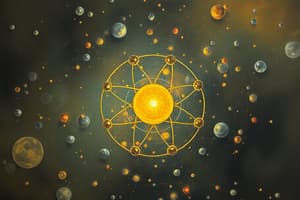Podcast
Questions and Answers
What does the Bohr model propose about the movement of electrons around the nucleus?
What does the Bohr model propose about the movement of electrons around the nucleus?
- Electrons orbit the nucleus in fixed energy levels. (correct)
- Electrons can exist in any position around the nucleus.
- Electrons spiral into the nucleus gradually.
- Electrons move in random paths around the nucleus.
How do electrons transition between energy levels in the Bohr model?
How do electrons transition between energy levels in the Bohr model?
- Electrons jump and emit energy as light when moving between levels. (correct)
- Electrons can exist freely between levels.
- Electrons can create energy by staying at a fixed level.
- Electrons remain in higher energy levels indefinitely.
What conclusion did Rutherford reach about the structure of the atom from his gold foil experiment?
What conclusion did Rutherford reach about the structure of the atom from his gold foil experiment?
- Atoms consist of nothing but electrons.
- Atoms are homogeneous, with electrons spread uniformly.
- Electrons are concentrated in the nucleus.
- The positive charge is concentrated in a small central region. (correct)
What aspect of the atom did the gold foil experiment demonstrate?
What aspect of the atom did the gold foil experiment demonstrate?
What principle did Werner Heisenberg introduce regarding the behavior of electrons?
What principle did Werner Heisenberg introduce regarding the behavior of electrons?
What aspect of electron energy levels differs between classical physics and the Bohr model?
What aspect of electron energy levels differs between classical physics and the Bohr model?
What did Niels Bohr introduce in his model of the atom?
What did Niels Bohr introduce in his model of the atom?
What is the primary characteristic of orbitals in the quantum mechanical model of the atom?
What is the primary characteristic of orbitals in the quantum mechanical model of the atom?
Which of the following correctly describes the nucleus in Rutherford's nuclear model?
Which of the following correctly describes the nucleus in Rutherford's nuclear model?
What was a surprising observation made by Rutherford during his experiment?
What was a surprising observation made by Rutherford during his experiment?
What discovery did James Chadwick make that completed the understanding of the atomic nucleus?
What discovery did James Chadwick make that completed the understanding of the atomic nucleus?
In the context of atomic structure, what effect does the empty space in atoms have?
In the context of atomic structure, what effect does the empty space in atoms have?
What happens when an electron absorbs energy in the Bohr model?
What happens when an electron absorbs energy in the Bohr model?
According to Rutherford's nuclear model, where do electrons reside in relation to the nucleus?
According to Rutherford's nuclear model, where do electrons reside in relation to the nucleus?
What is a significant difference between the Bohr model and the quantum mechanical model?
What is a significant difference between the Bohr model and the quantum mechanical model?
What are the vertical columns in the periodic table called?
What are the vertical columns in the periodic table called?
Which statement accurately reflects the charges within the atom according to the Plum Pudding Model?
Which statement accurately reflects the charges within the atom according to the Plum Pudding Model?
Which group in the periodic table contains the alkali metals?
Which group in the periodic table contains the alkali metals?
How many periods are there in the periodic table?
How many periods are there in the periodic table?
Which of the following best describes the behavior of elements across a period from left to right?
Which of the following best describes the behavior of elements across a period from left to right?
What is the main characteristic of nonmetals in the periodic table?
What is the main characteristic of nonmetals in the periodic table?
Which group contains noble gases?
Which group contains noble gases?
What type of elements are primarily found on the left and center of the periodic table?
What type of elements are primarily found on the left and center of the periodic table?
Which blocks in the periodic table correspond to groups 1 and 2?
Which blocks in the periodic table correspond to groups 1 and 2?
What does the spin quantum number (mₛ) represent?
What does the spin quantum number (mₛ) represent?
Which of the following correctly describes the shape of a p-orbital?
Which of the following correctly describes the shape of a p-orbital?
According to Hund's rule, how do electrons fill orbitals of the same sublevel?
According to Hund's rule, how do electrons fill orbitals of the same sublevel?
What does the Aufbau principle state about electron configuration?
What does the Aufbau principle state about electron configuration?
Which of the following quantum numbers corresponds to the shape of an orbital?
Which of the following quantum numbers corresponds to the shape of an orbital?
According to the Pauli Exclusion Principle, what restriction is placed on electrons within the same atom?
According to the Pauli Exclusion Principle, what restriction is placed on electrons within the same atom?
Which statement is true regarding electron configuration?
Which statement is true regarding electron configuration?
What is the maximum number of electrons that can occupy a single orbital?
What is the maximum number of electrons that can occupy a single orbital?
Who is considered the father of the modern periodic table?
Who is considered the father of the modern periodic table?
What was a unique feature of Mendeleev's periodic table?
What was a unique feature of Mendeleev's periodic table?
Which scientist organized elements by atomic number instead of atomic mass?
Which scientist organized elements by atomic number instead of atomic mass?
What did Mendeleev predict about elements such as gallium and germanium?
What did Mendeleev predict about elements such as gallium and germanium?
Which of the following contributions is associated with Julius Lothar Meyer?
Which of the following contributions is associated with Julius Lothar Meyer?
What is the significance of Henry Moseley's work in relation to Mendeleev's periodic table?
What is the significance of Henry Moseley's work in relation to Mendeleev's periodic table?
Which of the following scientists proposed the Law of Octaves?
Which of the following scientists proposed the Law of Octaves?
What was an important legacy of Mendeleev's periodic table?
What was an important legacy of Mendeleev's periodic table?
Flashcards are hidden until you start studying
Study Notes
Atomic Models Overview
- Plum Pudding Model: Proposed by J.J. Thomson, suggests atoms consist of positively charged substance with electrons embedded throughout for neutral overall charge.
Nuclear Model
- Ernest Rutherford (1911): Introduced the nuclear model, identifying a small, dense, positively charged nucleus after the gold foil experiment.
Gold Foil Experiment
- Rutherford directed alpha particles at a thin sheet of gold foil.
- Results: Most particles passed through, while a small fraction were deflected or bounced back, suggesting a concentrated positive charge in a nucleus rather than a spread-out charge.
Key Features of Rutherford’s Model
- Nucleus: Central core containing most of atom's mass, made of protons and later discovered neutrons.
- Electrons: Negatively charged and orbit the nucleus in large distances, resulting in mostly empty atom space.
- Density Comparison: The nucleus is significantly smaller than the entire atom, concentrating positive charge and mass in a tiny area.
Bohr Model
- Niels Bohr (1913): Advanced Rutherford's model by proposing electrons orbit the nucleus in fixed energy levels or shells, similar to planet orbits.
Key Features of Bohr Model
- Fixed Orbits: Electrons occupy specific, quantized energy levels, preventing them from spiraling into the nucleus.
- Energy Transitions: Electrons can move between energy levels by absorbing or emitting energy in the form of light.
- Line Spectra: Explained spectral lines emanating from hydrogen and other elements due to electron transitions.
Quantum Mechanical Model of the Atom
- Developed through quantum mechanics, highlighting limitations of previous models.
- Erwin Schrödinger: Proposed that electrons exist in probability clouds (orbitals) rather than fixed paths.
- Werner Heisenberg: Uncertainty Principle asserts it's impossible to know both position and momentum of an electron simultaneously.
- James Chadwick (1932): Discovered the neutron, completing the understanding of atomic nucleus composition.
Quantum Numbers
- Principal Quantum Number (n): Indicates energy level.
- Azimuthal Quantum Number (l): Reflects subshell shape (s, p, d, f).
- Magnetic Quantum Number (ml): Represents orientation of orbitals.
- Spin Quantum Number (ms): Describes electron spin, either +1/2 or -1/2.
Electron Configuration
- Aufbau Principle: Electrons fill low-energy orbitals before higher ones.
- Hund’s Rule: Electrons fill degenerate orbitals singly before pairing.
- Pauli Exclusion Principle: No two electrons can have identical quantum numbers; maximum of two electrons per orbital.
Discovery of the Periodic Table
- Dmitri Mendeleev (1834–1907): Father of the modern periodic table, arranged elements by atomic mass and predicted properties of undiscovered elements.
- Julius Lothar Meyer (1830–1895): Independently created a periodic table, highlighting periodic trends in properties with atomic volume.
Modifications to the Periodic Table
- Henry Moseley (1887–1915): Organized elements by atomic number, improving upon Mendeleev’s atomic mass arrangement.
- John Newlands (1837–1898): Proposed the Law of Octaves, suggesting a periodic relation of properties every eight elements.
Structure of the Periodic Table
- Groups: Vertical columns (18 total), where elements in the same group share similar chemical properties due to the same number of valence electrons.
- Periods: Horizontal rows (7 total), with an increase in atomic number from left to right and a decrease in metallic character.
Element Blocks
- Categories: Metals on the left, nonmetals on the right, and metalloids between with variable properties.
- Subshells: s-block (Groups 1-2), p-block (Groups 13-18), highlighting the filling of specific orbital types within the periodic table.
Studying That Suits You
Use AI to generate personalized quizzes and flashcards to suit your learning preferences.




